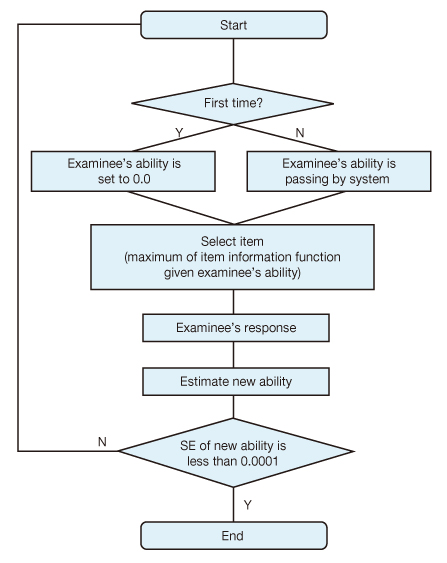J Korean Med Assoc.
2012 Feb;55(2):124-130. 10.5124/jkma.2012.55.2.124.
Can computerized tests be introduced to the Korean Medical Licensing Examination?
- Affiliations
-
- 1Department of Parasitology, College of Medicine, Hallym University, Chuncheon, Korea. shuh@hallym.ac.kr
- 2Institute of Medical Education, College of Medicine, Hallym University, Chuncheon, Korea.
- KMID: 2192660
- DOI: http://doi.org/10.5124/jkma.2012.55.2.124
Abstract
- In November 2011, the standing Committee of the Korean Medical Licensing Examination (KMLE) recommended that the National Health Personnel Licensing Examination Board introduce computerized testing to the KMLE. Therefore this article contextualizes and explores the possibility of applying computerized testing to the KMLE. Computerized testing comprises computer-based testing (CBT), ubiquitous-based testing (UBT), internet-based testing (IBT), and computerized adaptive testing (CAT). CBT refers to testing administered via a computer as the user interface, while testing with a smart phone or smart pad as the user interface is known as UBT. IBT is testing done online, and CAT is testing tailored so that each item provided fits the examinee's ability level. The benefits and drawbacks of each computerized testing option were surveyed. Among them, I propose CAT as the final goal for KMLE. In order to implement the computerized testing more effectively, it is recommended that items contain multimedia data and should involve interpretation or problem-solving. More evidence is needed to support the positive impact of computerized testing for undergraduate medical education and primary health care. Since the rapid progress of information technology such as internet bandwidth and human-computer interface methods, the introduction of computerized testing to KMLE will soon be plausible. It is possible to increase the quality of the KMLE with the introduction of computerized testing. Medical schools should prepare for the new testing environment of the KMLE by recruiting or training specialists in this field.
MeSH Terms
Figure
Cited by 2 articles
-
How can high stakes examination in Korean medical society be improved to the international level?
Sun Huh
J Korean Med Assoc. 2012;55(2):114-115. doi: 10.5124/jkma.2012.55.2.114.The legality and appropriateness of keeping Korean Medical Licensing Examination items confidential: a comparative analysis and review of court rulings
Jae Sun Kim, Dae Un Hong, Ju Yoen Lee, Sun Huh
J Educ Eval Health Prof. 2024;21:28. doi: 10.3352/jeehp.2024.21.28.
Reference
-
1. English interpretation and translation testing through smart phone first in the world. Herald Gyeongje. 2009. 09. 28.2. Huh S. Application of computerized adaptive testing in medical education. Korean J Med Educ. 2009. 21:97–102.
Article3. Lee YH, Park JH, Park IY. Estimation of an examinee's ability in the web-based computerized adaptive testing program IRT-CAT. J Educ Eval Health Prof. 2006. 3:4.
Article4. Huh S. Preparing the implementation of computerized adaptive testing for high-stakes examinations. J Educ Eval Health Prof. 2008. 5:1.
Article5. Kim KS. President's address: improving the quality of testing. J Educ Eval Health Prof. 2011. 8:1.
Article6. Jeong GH, Yim MK. Applicability of item response theory to the Korean Nurses' Licensing Examination. J Educ Eval Health Prof. 2005. 2:23–29.
Article7. Yim MK, Huh S. Testing unidimensionality and goodness-of-fitness for the application of item response theory to the Korean Medical Licensing Examination. Korean J Med Educ. 2007. 19:163–169.
Article8. Lim EY, Park JH, Kwon L, Song GL, Huh S. Comparison of item analysis results of Korean Medical Licensing Examination according to classical test theory and item response theory. J Educ Eval Health Prof. 2004. 1:67–76.
Article9. Yim MK, Huh S. Test equating of the Medical Licensing Examination in 2003 and 2004 based on the item response theory. J Educ Eval Health Prof. 2006. 3:2.
Article10. Im EJ, Lee WK, Lee YC, Choe BH, Chung SK, Lee TH, Cho H, Sohn JH, Won DI, Kong HH, Chang BH, Lee JM. Development of computer-based test (CBT) and student recognition survey on CBT. Korean J Med Educ. 2008. 20:145–154.
Article11. Kim MY, Huh S. Students' attitude toward and acceptability of computerized adaptive testing in medical school and their effect on the examinees' ability. J Educ Eval Health Prof. 2005. 2:105–111.
Article12. Lee YH. Introduction to an open source internet-based testing program for medical student examinations. J Educ Eval Health Prof. 2009. 6:4.
Article13. Kim KS. Introduction and administration of the clinical skill test of the medical licensing examination, Republic of Korea (2009). J Educ Eval Health Prof. 2010. 7:4.
Article14. Huh S. Simple check list for making test item. Korean J Med Educ. 2010. 22:71.
Article15. Kim S. The future of e-learning in medical education: current trend and future opportunity. J Educ Eval Health Prof. 2006. 3:3.
Article16. Huh S. Where can I find the free item analysis program based on item response theory, computer-based testing and computerized adaptive testing? Korean J Med Educ. 2010. 22:323–324.
Article17. Huh S. What should be prepared for the mutual accreditation for medical health licenses when Korea opens to physicians and dentists from the rest of the world. J Educ Eval Health Prof. 2007. 4:2.
Article
- Full Text Links
- Actions
-
Cited
- CITED
-
- Close
- Share
- Similar articles
-
- Correlations between the scores of computerized adaptive testing, paper and pencil tests, and the Korean Medical Licensing Examination
- Presidential address: Adoption of a clinical skills examination for dental licensing, implementation of computer-based testing for the medical licensing examination, and the 30th anniversary of the Korea Health Personnel Licensing Examination Institute
- Presidential address: demonstration of the international leadership of the Korea Health Personnel Licensing Examination Institute, introduction of a clinical skills test to the Korean dental licensing examination, and strengthening of ethics items on licensing examinations
- Presidential address: Quarantine guidelines to protect examinees from coronavirus disease 2019, clinical skills examination for dental licensing, and computer-based testing for medical, dental, and oriental medicine licensing
- Testing Unidimensionality and Goodness-of-fitness for the Application of Item Response Theory to the Korean Medical Licensing Examination


